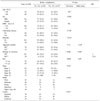Abstract
Purpose
The aim of this study was to investigate the risk factors of reflux associated complications (reflux symptoms, reflux esophagitis, and esophageal stricture) after gastrectomy for proximal gastric cancer.
Methods
150 patients with proximal gastric cancer were included from January 2005 to December 2008. Their medical and surgical records were retrospectively analyzed concerning clinical and pathologic characteristics, operation methods, morbidity, reflux associated complications and nutritional states.
Results
Tumor sizes and operation methods were statistically significant in univariate analysis of risk factors for reflux associated complications (P<0.05). However, only operation methods were statistically significant in multivariate analysis (P=0.00). We, thus, compared operation methods. There were no significant differences in morbidity, body weight, hemoglobin, serum cholesterol, protein and albumin between total gastrectomy groups and proximal gastrectomy groups (P>0.05). However, reflux complications were significantly more common in proximal gastrectomy groups (72.4%) than in total gastrectomy groups (29.5%). Severe reflux esophagitis (LA classification C or D) was found in only proximal gastrectomy groups.
Figures and Tables
References
1. Hyung WJ, Kim SS, Choi WH, Cheong JH, Choi SH, Kim CB, et al. Changes in treatment outcomes of gastric cancer surgery over 45 years at a single institution. Yonsei Med J. 2008. 49:409–415.
2. Salvon-Harman JC, Cady B, Nikulasson S, Khettry U, Stone MD, Lavin P. Shifting proportions of gastric adenocarcinomas. Arch Surg. 1994. 129:381–389.
3. Lee HJ, Yang HK, Ahn YO. Gastric cancer in Korea. Gastric Cancer. 2002. 5:177–182.
4. An JY, Youn HG, Choi MG, Noh JH, Sohn TS, Kim S. The difficult choice between total and proximal gastrectomy in proximal early gastric cancer. Am J Surg. 2008. 196:587–591.
5. Kim EM, Jeong HY, Lee ES, Moon HS, Sung JK, Kim SH, et al. Comparision between proximal gastrectomy and total gastrectomy in early gastric cancer. Korean J Gastroenterol. 2009. 54:212–219.
6. Shiraishi N, Adachi Y, Kitano S, Kakisako K, Inomata M, Yasuda K. Clinical outcome of proximal versus total gastrectomy for proximal gastric cancer. World J Surg. 2002. 26:1150–1154.
7. Matsukuma A, Furusawa M, Tomoda H, Seo Y. A clinicopathological study of asymptomatic gastric cancer. Br J Cancer. 1996. 74:1647–1650.
8. Sugiura T, Iwakiri K, Kotoyori M, Kobayashi M. Relationship between severity of reflux esophagitis according to the Los Angeles classification and esophageal motility. J Gastroenterol. 2001. 36:226–230.
9. Olbe L, Lundell L. Intestinal function after total gastrectomy and possible consequences of gastric replacement. World J Surg. 1987. 11:713–719.
10. Inberg MV, Heinonen R, Laurén P, Rantakokko V, Viikari SJ. Total and proximal gastrectomy in the treatment of gastric carcinoma: a series of 305 cases. World J Surg. 1981. 5:249–257.
11. Nakane Y, Michiura T, Inoue K, Sato M, Nakai K, Ioka M, et al. Role of pyloroplasty after proximal gastrectomy for cancer. Hepatogastroenterology. 2004. 51:1867–1871.
12. Mannell A, McKnight A, Esser JD. Role of pyloroplasty in the retrosternal stomach: results of a prospective, randomized, controlled trial. Br J Surg. 1990. 77:57–59.
13. Noh SM, Bae JS, Jeong HY, Cho JS, Shin KS, Song KS, et al. Clinical study of the pylorus preserving proximal subtotal gastrectomy. J Korean Surg Soc. 2000. 59:759–764.
14. Noh SM, Jeong HY, Lee BS, Cho JS, Shin KS, Song KS, et al. Pylorus-preserving proximal gastrectomy vs. total gastrectomy with jejunal interposition for proximal gastric adenocarcinomas. J Korean Gastric Cancer Assoc. 2002. 2:145–150.
15. Yoo CH, Sohn BH, Han WK, Pae WK. Proximal gastrectomy reconstructed by jejunal pouch interposition for upper third gastric cancer: prospective randomized study. World J Surg. 2005. 29:1592–1599.
16. Takeshita K, Saito N, Saeki I, Honda T, Tani M, Kando F, et al. Proximal gastrectomy and jejunal pouch interposition for the treatment of early cancer in the upper third of the stomach: surgical techniques and evaluation of postoperative function. Surgery. 1997. 121:278–286.
17. Hinoshita E, Takahashi I, Onohara T, Nishizaki T, Matsusaka T, Wakasugi K, et al. The nutritional advantages of proximal gastrectomy for early gastric cancer. Hepatogastroenterology. 2001. 48:1513–1516.
18. Schwarz A, Buchler M, Usinger K, Rieger H, Glasbrenner B, Friess H, et al. Importance of the duodenal passage and pouch volume after total gastrectomy and reconstruction with the Ulm pouch: prospective randomized clinical study. World J Surg. 1996. 20:60–67.
19. Kim JH, Park SS, Kim J, Boo YJ, Kim SJ, Mok YJ, et al. Surgical outcomes for gastric cancer in the upper third of the stomach. World J Surg. 2006. 30:1870–1878.
20. Matsushiro T, Hariu T, Nagashima H, Yamamoto K, Imaoka Y, Yamagata R, et al. Valvuloplasty plus fundoplasty to prevent esophageal regurgitation in esophagogastrostomy after proximal gastrectomy. Am J Surg. 1986. 152:314–319.
21. Jung HJ, Kim DH, Kim DH. Proximal gastrectomy with double tract reconstruction using the remnant antrum in early upper gastric cancer. J Korean Surg Soc. 2008. 74:261–266.
22. Sakuramoto S, Yamashita K, Kikuchi S, Futawatari N, Katada N, Moriya H, et al. Clinical experience of laparoscopy-assisted proximal gastrectomy with Toupet-like partial fundoplication in early gastric cancer for preventing reflux esophagitis. J Am Coll Surg. 2009. 209:344–351.




 PDF
PDF ePub
ePub Citation
Citation Print
Print






 XML Download
XML Download